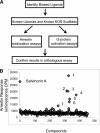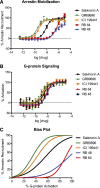Identification of novel functionally selective κ-opioid receptor scaffolds
- PMID: 24113749
- PMCID: PMC3868907
- DOI: 10.1124/mol.113.089649
Identification of novel functionally selective κ-opioid receptor scaffolds
Abstract
The κ-opioid receptor (KOR)-dynorphin system has been implicated in the control of affect, cognition, and motivation, and is thought to be dysregulated in mood and psychotic disorders, as well as in various phases of opioid dependence. KOR agonists exhibit analgesic effects, although the adverse effects produced by some KOR agonists, including sedation, dysphoria, and hallucinations, have limited their clinical use. Interestingly, KOR-mediated dysphoria, assessed in rodents as aversion, has recently been attributed to the activation of the p38 mitogen-activated protein kinase pathway following arrestin recruitment to the activated KOR. Therefore, KOR-selective G protein-biased agonists, which do not recruit arrestin, have been proposed to be more effective analgesics, without the adverse effects triggered by the arrestin pathway. As an initial step toward identifying novel biased KOR agonists, we applied a multifaceted screening strategy utilizing both in silico and parallel screening approaches. We identified several KOR-selective ligand scaffolds with a range of signaling bias in vitro. The arylacetamide-based scaffold includes both G protein- and β-arrestin-biased ligands, while the endogenous peptides and the diterpene scaffolds are G protein biased. Interestingly, we found scaffold screening to be more successful than library screening in identifying biased ligands. Many of the identified functionally selective ligands are potent selective KOR agonists that are reported to be active in the central nervous system. They therefore represent excellent candidates for in vivo studies aiming at determining the behavioral effects mediated by specific KOR-mediated signaling cascades.
Figures


Similar articles
-
Structure-activity relationship studies of functionally selective kappa opioid receptor agonists that modulate ERK 1/2 phosphorylation while preserving G protein over βarrestin2 signaling bias.ACS Chem Neurosci. 2015 Aug 19;6(8):1411-9. doi: 10.1021/acschemneuro.5b00092. Epub 2015 May 1. ACS Chem Neurosci. 2015. PMID: 25891774 Free PMC article.
-
The G protein-biased κ-opioid receptor agonist RB-64 is analgesic with a unique spectrum of activities in vivo.J Pharmacol Exp Ther. 2015 Jan;352(1):98-109. doi: 10.1124/jpet.114.216820. Epub 2014 Oct 15. J Pharmacol Exp Ther. 2015. PMID: 25320048 Free PMC article.
-
Signaling Properties of Structurally Diverse Kappa Opioid Receptor Ligands: Toward in Vitro Models of in Vivo Responses.ACS Chem Neurosci. 2019 Aug 21;10(8):3590-3600. doi: 10.1021/acschemneuro.9b00195. Epub 2019 Jul 31. ACS Chem Neurosci. 2019. PMID: 31313902
-
A systematic review on the kappa opioid receptor and its ligands: New directions for the treatment of pain, anxiety, depression, and drug abuse.Eur J Med Chem. 2022 Dec 5;243:114785. doi: 10.1016/j.ejmech.2022.114785. Epub 2022 Sep 22. Eur J Med Chem. 2022. PMID: 36179400 Review.
-
Biased Opioid Ligands.Molecules. 2020 Sep 16;25(18):4257. doi: 10.3390/molecules25184257. Molecules. 2020. PMID: 32948048 Free PMC article. Review.
Cited by
-
Opioid receptors: Structural and mechanistic insights into pharmacology and signaling.Eur J Pharmacol. 2015 Sep 15;763(Pt B):206-13. doi: 10.1016/j.ejphar.2015.05.012. Epub 2015 May 14. Eur J Pharmacol. 2015. PMID: 25981301 Free PMC article. Review.
-
Structure-activity relationship studies of functionally selective kappa opioid receptor agonists that modulate ERK 1/2 phosphorylation while preserving G protein over βarrestin2 signaling bias.ACS Chem Neurosci. 2015 Aug 19;6(8):1411-9. doi: 10.1021/acschemneuro.5b00092. Epub 2015 May 1. ACS Chem Neurosci. 2015. PMID: 25891774 Free PMC article.
-
Dynorphin Controls the Gain of an Amygdalar Anxiety Circuit.Cell Rep. 2016 Mar 29;14(12):2774-83. doi: 10.1016/j.celrep.2016.02.069. Epub 2016 Mar 17. Cell Rep. 2016. PMID: 26997280 Free PMC article.
-
Evaluation of the Intracellular Signaling Activities of κ-Opioid Receptor Agonists, Nalfurafine Analogs; Focusing on the Selectivity of G-Protein- and β-Arrestin-Mediated Pathways.Molecules. 2022 Oct 19;27(20):7065. doi: 10.3390/molecules27207065. Molecules. 2022. PMID: 36296658 Free PMC article.
-
Opioid signaling and design of analgesics.Prog Mol Biol Transl Sci. 2023;195:153-176. doi: 10.1016/bs.pmbts.2022.06.017. Epub 2022 Aug 5. Prog Mol Biol Transl Sci. 2023. PMID: 36707153 Free PMC article. Review.
References
-
- Appleyard SM, Patterson TA, Jin W, Chavkin C. (1997) Agonist-induced phosphorylation of the kappa-opioid receptor. J Neurochem 69:2405–2412 - PubMed
-
- Bhatnagar A, Willins DL, Gray JA, Woods J, Benovic JL, Roth BL. (2001) The dynamin-dependent, arrestin-independent internalization of 5-hydroxytryptamine 2A (5-HT2A) serotonin receptors reveals differential sorting of arrestins and 5-HT2A receptors during endocytosis. J Biol Chem 276:8269–8277 - PubMed
-
- Black JW, Leff P. (1983) Operational models of pharmacological agonism. Proc R Soc Lond 220:141–162 - PubMed
Publication types
MeSH terms
Substances
Grants and funding
- K05DA022413/DA/NIDA NIH HHS/United States
- R01 DA027170/DA/NIDA NIH HHS/United States
- CAPMC/ CIHR/Canada
- U19MH82441/MH/NIMH NIH HHS/United States
- 092809/Z/10/Z/WT_/Wellcome Trust/United Kingdom
- K05 DA022413/DA/NIDA NIH HHS/United States
- R01MH54137/MH/NIMH NIH HHS/United States
- 092809/WT_/Wellcome Trust/United Kingdom
- WT_/Wellcome Trust/United Kingdom
- R01DA027170/DA/NIDA NIH HHS/United States
- R01 MH054137/MH/NIMH NIH HHS/United States
- U19 MH082441/MH/NIMH NIH HHS/United States
- R01 DA017204/DA/NIDA NIH HHS/United States
- R01DA01724/DA/NIDA NIH HHS/United States
- T32 GM007040/GM/NIGMS NIH HHS/United States
LinkOut - more resources
Full Text Sources
Other Literature Sources
Research Materials
